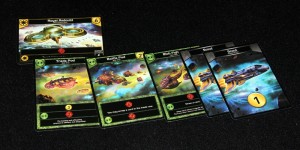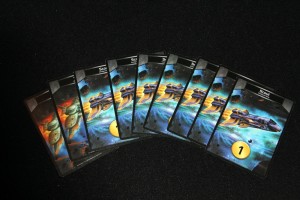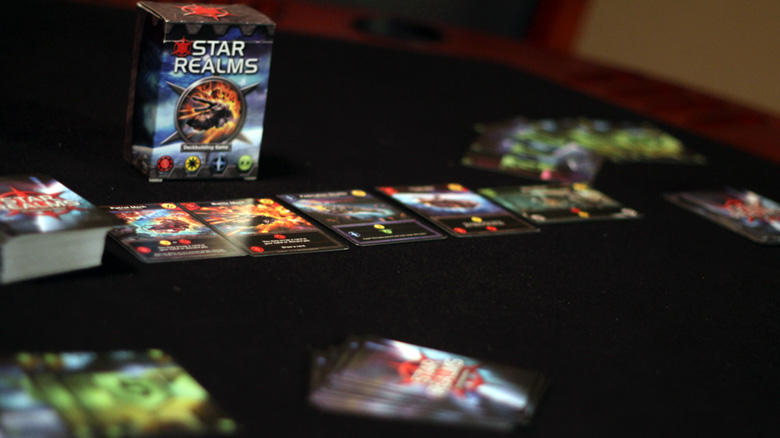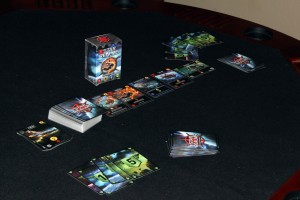 Collectible card games (CCGs) exploded onto the scene in 1993 with Magic: The Gathering. Throughout the years, their popularity waxed and waned, but today Magic and other CCGs are more popular than they have ever been. If you don’t believe me, ask any Magic player about card prices on the secondary market. Despite the high financial barrier to entry, CCGs have given gamers a mono-et-mono battle that just isn’t replicated in many board and card games.
Collectible card games (CCGs) exploded onto the scene in 1993 with Magic: The Gathering. Throughout the years, their popularity waxed and waned, but today Magic and other CCGs are more popular than they have ever been. If you don’t believe me, ask any Magic player about card prices on the secondary market. Despite the high financial barrier to entry, CCGs have given gamers a mono-et-mono battle that just isn’t replicated in many board and card games.
Star Realms aims to create a direct conflict game that feels a lot like a CCG, but is played out of a single box retailing for $15. Star Realms is designed by two former Magic: The Gathering pros and Hall of Fame members, Robert Dougherty and Darwin Castle and published by White Wizard Games. At its heart, Star Realms is a deck builder. However, there are no bosses to attack or super villains to team up against. The focus is player-vs-player combat, and the last man standing wins.
Star Realms is a 2-player game that plays in about 20 minutes. There are multiplayer variants that require additional copies of the game.
Game Overview:
In Star Realms, you will use the cards in your deck to purchase more advanced ships, deploy bases, destroy enemy bases, and then destroy your enemy. Each player starts with 10 cards, eight scouts that provide one trade when played and two vipers that can damage enemies. You can spend trade to buy ships or bases from the trade row, which will go to your discard pile and eventually be shuffled into your deck to draw from. Ships are aligned with one of four factions: the Trade Federation, The Blobs, The Star Empire, and The Machine Cult. Playing multiple cards from the same faction often gives additional bonuses, enticing players to become invested in one or two of the factions and adopt a strategy around their strengths. Be the first to reduce your opponent’s authority down to zero and you win.
Components:

Star Realms is packaged in a tuckbox with a rules insert, 80 trade cards, 20 starting cards, 10 explorers cards, and 18 authority cards that can be used for keeping track of life totals (or authority as the game calls it). For a game that is all about the cards, the artwork on those cards is pretty lackluster. All The Blob ships look like they are emitting some green goo. All the ships aligned to The Machine Cult are firing missiles in every direction. The most powerful ships and the mundane average ships all look pretty much the same.
Base cards suffer from the same boring artwork as the ships. However, I’ve had another very minor problem with the bases, they are oriented horizontally on the card. This allows you to very easily tell the difference between a ship and a base, and initially this made a lot of sense. Unfortunately, they often end up back in your discard pile upside-down, so they essentially become marked cards in the deck. Again, this is pretty minor and seems like once I’ve got a few dozen more plays in I’ll be much better at instinctively turning the bases the right direction in the discard.
How To Play:
If you’ve played any deck builder games before you will have no trouble getting right into a game of Star Realms. Each player starts with the same 10 cards in their deck. The player who is going first only gets to draw 3 on his or her opening turn. On all other turns, each player will draw 5 cards. Five cards will also be revealed face-up from the trade deck to form the trade row and are available to acquire. Once a card is acquired, it is immediately replaced from the top of the trade deck.

Some cards will produce trade, others combat, and often cards have other abilities like drawing a card, making your opponent discard, or removing cards in your deck from the game. Additionally, there may be “ally abilities” which trigger if you play another card from the same faction.
Cards that produce trade will allow you to make your deck stronger with additional ships and bases. Bases, once drawn and played, will stay out in front of you. This can be extremely powerful as their ability happens every turn and also counts as an ally of whatever faction they are aligned with and therefore help to trigger ally abilities of other cards. Combat is used to attack your opponent’s authority or your opponent’s bases. So while its helpful to buy ships that give you a lot of trade, you ultimately need combat ships that can do a lot of damage to finish off your opponent.
Many cards in Star Realms also have a scrap ability. This ability gives you an extra bonus if you choose to scrap that ship or base. The scrapped card is removed from the game entirely and is not shuffled back into the deck.
Both players start are 50 authority points. When a player is reduced to 0, they are eliminated.

Game Experience:
As a seasoned, dedicated Magic: The Gathering player, Star Realms really hits a home run for me. It’s certainly not Magic, not in terms of complexity, cost, design, or artwork. But the feeling of direct combat, me versus you, to see who wins is something that hasn’t existed in a deck builder before. It scratches a competitive itch that I’ve always had in a very similar way to Magic, and a way that other games fail to do. While everyone, myself included, draws the obvious comparison to CCGs, there is a lot to love here for most gamers, regardless if you’ve played CCGs before or not. Star Realms is a great two player deck builder.
The game is well-balanced, each of the factions provide viable methods of winning. The Blob faction is probably overpowered a bit, but just because your opponent has some cards from one faction doesn’t stop you from acquiring them as well. Almost every turn has an interesting decision to be made. Do you buy a weaker card in a faction you have a large number of? Or let it go to buy a powerful card in a faction you currently haven’t acquired. Maybe you would be better off taking that Blob ship from the trade row knowing your opponent already has a lot of Blobs, just to prevent him from getting it.

Despite the many decisions to be made, there is a lot of luck involved in winning a game of Star Realms. A powerful ship revealed after your opponent just had to buy two or three low-cost ships can really turn a game. And just like any deck builder, there is always the possibility you draw a couple of hands in a row of really low impact cards. Personally, I think it’s just about the right skill/luck mix, especially for a game that plays out in a brisk 15 or 20 minutes.
Combat is often less interesting than the acquiring step. Unless you can kill your opponent during the turn, it’s almost always best to destroy their bases and just hit them with whatever is left over. There are no abilities or cards that can be played on an opponent’s turn, so you are always working with near perfect information. However, as simple as that sounds, I’ve found myself way behind in many games because I didn’t take enough combat cards early. If you opponent has multiple bases in play and you can’t destroy them, you aren’t going to last very long. There is a real balancing act to making sure you have enough trade to buy ships and enough combat to keep bases out of play.
We have experienced some games where the trade row is full of high-cost cards early and leads to a slow developing game. It’s not an uncommon problem for deck builders, but can really drag down a game of Star Realms since it normally plays out pretty quickly.
The scrap ability on many of the cards adds a bit more strategy and is a mechanic I haven’t seen in a deck builder previously. The scrap ability on low-cost cards can thin them out of your deck later in the game when you would rather be doing something more powerful. On powerful cards the scrap ability often represents a way to deliver a final blow or a powerful one-time effect that can help you catch up from behind.
A simple deck builder at the root of it, I love Star Realms for how easy it is to pick up and learn. For anyone familiar with deck building, it only takes about 5 minutes to explain the minor tweaks and get your first battle underway. It’s a fantastic game that plays more like a CCG than anything else on the market. And for $15. The price point cannot be forgotten here. For the cost of a pretty solid rare from a collectible game, you can get a full two-player game that creates a pretty similar experience.
Finals Thoughts:
Direct combat isn’t everyone’s idea of a good time. If it is your cup of tea though, you’ll love it. Star Realms is the kind of deck builder you would hope for from two Magic: the Gathering Hall of Fame pros. Different factions lead down different strategic paths. Bases that go unchecked can end a game quickly, so combat ships have to be purchased early. Even those that haven’t been consumed by a CCG should give Star Realms a shot.
Most deck builders play well with all player counts, but Star Realms is the best two player deck builder I’ve played. Unlike Legendary, where you have a cooperative element, Star Realms is very clear about what the intentions are. Destroy the other player. Not to mention you can start and finish a game of Star Realms in about the time it takes to set up a game of Legendary.
There is an additional pack that will be available in October that adds a cooperative and solo variant to the game. I should also mention for the technologically inclined, there is a cross-platform Star Realms app that is a great way to play the game digitally.
Star Realms does have a bit of a limited market. If you don’t play a lot of 2-player games, this isn’t for you. If you are a strict eurogamer that doesn’t enjoy direct combat, this is a pass.
For the rest of you, Star Realms is available now for $15.
Final Score: 3.5 stars – A great two player deck builder. Combat feels a lot like the CCG and plays quickly enough to not overstay its welcome.
 Hits:
Hits:
• Unique direct combat system
• Lots of interesting, strategic decisions
• Easy to learn, low price point
• Plays in about 20 minutes
Misses:
• Artwork isn’t appealing
• Requires additional copies of the game for 3+ players






















A couple of times in this review the coment apeared for those who have played card building games before learning star realms should be no problem. Well I have never played a card building game before. I found the rules vague and confusing. The assumption the authors of the game made in assuming someone had a background in card building games turned a five minute learning the tricks of the game session into two hours of struggling to understand what they were talking about. from my reading of the rules it doesn’t explain at all what ally abilities are. It took two sentences from this review for me to understand what the mechanics of the game we’re trying to accomplish. It seems like whoever wrote the rules we’re trying to use as many words as they could to convey the least amount of information possible.. this might be a nice little 2 player card building game but you wouldn’t know it by me. Considering the assumptions made by the author of the rules I don’t know that I’m even going to try it again. I’ve played a couple of hundred different games not many compared to some but this is the sloppiest set of rules and instructions I’ve seen. Don’t make any assumptions about the people buying your game when writing rules. You might make a sale instead of lose one.